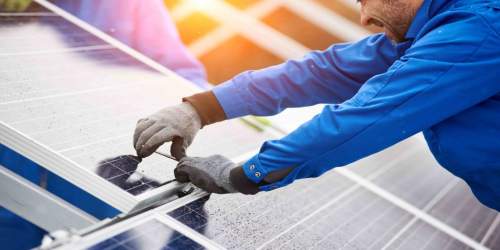Read Time : 3 Minutes
How do Solar Panels Generate Electricity
Solar energy is clean, reliable, and an ideal source of renewable energy. It can be used to heat the water in your home or produce electricity, and all without creating emissions or pollution. The very basics of how solar panels work and generate electricity are that the solar panels absorb the light from the sun and then use the energy from that to power your home. However, it’s actually a little more complex than that, and each of the components that make up the system has a vital role to play. This page takes you through how it all works by looking at each component individually.
Placement on the Roof
For most solar systems, the solar panels are placed on the roof (although there are some that are ground mounted). Ideally, the rooftop location will be free from any shade that may cover the panels – especially during the primary hours of 9am and 3pm. Generally, a south-facing installation will provide the optimum location for your system allowing it to make the most of the sunlight it receives.
However, it is possible for other orientations to provide equal levels of efficiency. Trees, buildings, and other potential obstructions that cause shading during the day will have a significant impact on the overall efficiency and power production of your solar system. If just one of the cells in your system becomes shaded, the power production levels can be reduced by more than half. Your installer will work to make sure shading is avoided.
Not every roof is able to provide the correct orientation or angle of inclination to take full advantage of the energy the sun provides. Some systems have been designed with pivoting panels that automatically track the sun and its journey across the sky. Non-tracking PV systems should be inclined at an angle that is equal to the site’s latitude in order to absorb the most energy throughout the year. Alternate orientations and inclinations may also be used to optimise the production of energy for a particular season or time of day.
COMPARE PRICES FROM LOCAL INSTALLERS
Compare prices from local companies fast & free
Enter your postcode to compare quotes from leading professionals. We promise to keep your information Safe & Secure. Privacy Policy
The Solar panels
Solar panels contain photovoltaic (PV) cells that are commonly made from silicon. These transform the incoming sunlight into energy as opposed to heat. Solar PV cells consist of a positive and negative film of silicon that is placed under a thin slice of glass. As the photons of sunlight reach these cells and hit them, they knock the electrons off the silicon. The negatively charged free electrons are specifically attracted to one side of the silicon cell, and this is what creates an electric voltage that can be collected and then channelled through the home.
The current is collected by wiring the individual solar panels together in a series to form what is known as a solar PV array. Multiple strings of solar PV array cables tend to terminate in one electrical box (depending on the size of the installation at hand). This is known as a fused array combiner. In the combiner box are fuses that are designed to protect the individual module cables, as well as the connections that deliver power to the inverter. The electricity that is produced at this stage is direct current (DC) and needs to be converted to alternating current (AC) in order to be suitable for use in your home or place of work.
The Inverter
The inverter is typically located in an accessible location, and close as practical to the modules. In a residential application, the inverter is often mounted to the exterior sidewall of the home near the electrical main or sub panels. Since inverters make a slight noise, this should be taken into consideration when selecting the location. What the inverter dies is turn the DC electricity that is generated by the solar panels into 120-volt AC. This can be put into use immediately by connecting the inverter directly to a dedicated circuit breaker in the electrical panel.
The inverter, electricity production meter, and electricity net meter are connected, so that power that is produced by your solar electric system will first be consumed by the electrical loads that are currently in operation. The balance of power that is created by your solar system then passes through your electrical panel before heading out onto the grid. Whenever you are producing more electricity that you are consuming at the time, your utility meter will turn backwards.
The Net meter
For solar electric systems that are also tied to the utility grid, the DC power from the solar array is converted into 120/240V AC power before being fed directly into the utility power distribution system of the building. The power is net metered, which means that it reduces the demand for power from the utility when the solar array is generating electricity. As a result, the utility bills are lowered.
The systems that are tied to the grid will shut off automatically if the utility power goes offline, preventing power being fed back into the grid during a power outage. Solar systems that fall under this category are known as on-grid or battery-less, and they make up around 98% of the solar systems that are currently being installed.
Want to Know More?
Have you found yourself interested in solar panels? If you're ready to speak to one of our approved installation companies, head over to our online directory. Or simply give us a ring using the number at the top of this page and have a chat.
Find a local installer
Welcome to the biggest directory of UK renewable energy companies





 How Much do Solar Panel Systems Cost in 2024?
How Much do Solar Panel Systems Cost in 2024?







